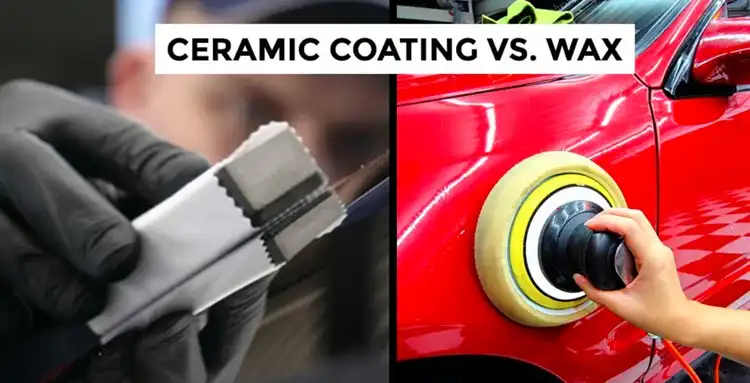No matter how often you wash your car, dust, dirt, and grime seem to accumulate quickly, making your car appear dull and dirty. This can be frustrating, especially if you take pride in having a spotless car. The good news is that new protective coatings like ceramic coating can help keep your car cleaner for longer.
Ceramic coatings create a hydrophobic layer on the car’s paint that repels water and contaminants. This makes regular maintenance easier by reducing the adherence of dirt, dust, bird droppings, and more. As a result, ceramic coatings can keep your car looking cleaner for longer between washes.
In this comprehensive guide, I’ll help you explore whether ceramic coatings live up to their promise of keeping your car clean. We’ll look at how ceramic coatings work, their effectiveness compared to traditional waxes and sealants, common myths, proper maintenance steps, and frequently asked questions. Read on to learn if a ceramic coating is worth investing in to make car washing less of a chore.

How Ceramic Coatings Keep Cars Clean?
Ceramic coatings provide a durable, non-porous glass-like layer over the car’s paintwork. This hydrophobic layer causes water to bead up and roll off the surface along with any loose contaminants. Here’s a closer look at how ceramic coatings repel dirt and grime:
- Repels Water and Contaminants
The slick ceramic coating reduces the surface tension of the paintwork, causing water to form droplets that easily roll off the car’s surface. Any loose dirt or debris on the paint gets picked up by the droplets and carried away. This self-cleaning effect makes regular maintenance washes easier.
- Creates a Smooth Surface
The ultra-smooth ceramic layer fills in swirls and light scratches in the clear coat, creating a perfectly smooth surface. This prevents dirt from getting trapped in imperfections in the paint. Contaminants remain on the surface of the ceramic coating instead of embedding in the paint.
- Forms a Protective Barrier
Ceramic coatings bond on a molecular level to the clear coat to form a durable, chemically resistant layer. This tough coating protects the paint underneath from chemical etching and environmental damage like bird droppings, sap, and bug splatter.
- Hydrophobic and Oleophobic Properties
Quality ceramic coatings are both hydrophobic and oleophobic, meaning they repel water as well as oils, grease, and other contaminants. This prevents oily grime from adhering strongly to the paint surface.
- Maintains Gloss and Paint Clarity
By keeping the paint pristine, ceramic coatings help maintain the car’s glossiness and paint clarity between washes. The coating’s light-refracting properties also enhance the paint’s depth, color, and shine.
So, ceramic coatings leverage nanotechnology to create a super slick barrier over automotive paint. By repelling water and grime, they help keep cars cleaner for longer.
Are Ceramic Coatings Effective at Keeping Cars Clean?
Ceramic coatings can be extremely effective at keeping cars cleaner between washes – but the level of effectiveness depends on several factors:
- Quality of the Ceramic Coating: Not all ceramic coatings are created equal. High-end ceramic coatings with concentrated SiO2 (silicon dioxide) provide better longevity, hydrophobicity, and durability compared to cheaper options. Reputable brands backed by warranties are best.
- Depth of Gloss and Smoothness: How well the ceramic coating levels the paint surface and refracts light impacts its water-beading and dirt-shedding capabilities. Professional application is key for achieving optimal smoothness and gloss.
- Frequency of Washing: Ceramic coatings make washing your car much easier and quicker by preventing dirt and contaminants from bonding. But regular washes are still essential approximately every 2 weeks.
- Proper Maintenance: Using automotive shampoos that are pH neutral, bird droppings and sap should be removed promptly, and topped up every 12-24 months. Proper maintenance maximizes longevity and performance.
- Environmental Factors: Ceramic coatings excel in areas with low dust and contaminants. In areas with hard water, road salts, environmental fallout, etc., more frequent washing is needed. Garage parking further reduces exposure.
When professionally applied and properly maintained, ceramic coatings can keep a car looking freshly detailed with 90% less effort compared to unprotected paint.
Ceramic Coating Myths
There are some common misconceptions about what ceramic coatings can and can’t do when it comes to keeping cars clean. Let’s separate fact from fiction:
Myth 1: It’s completely maintenance-free
While ceramic coatings reduce maintenance, they cannot eliminate it completely. Regular washing is still required, just less frequently. Proper care also prolongs the life of the coating.
Myth 2: It stays shiny perpetually
Ceramic coatings maintain gloss better than wax, but not indefinitely. Environmental contaminants will gradually dull the coating over time. Proper maintenance helps maintain the slickness and shine.
Myth 3: It’s scratch-proof
Ceramic coatings offer good scratch resistance but are not impenetrable. Light surface scratches can still occur, especially from automatic car washes. Hand washing is recommended.
Myth 4: Coating never needs reapplication
Depending on the product quality, ceramic coatings last 1-5 years before a top-up is needed. Higher-end coatings maintain their integrity longer.
Myth 5: A car never needs drying
The hydrophobic properties minimize water spotting but don’t prevent it completely. Some drying is still required after washing, especially on the glass.
How to Wash and Care for a Ceramic Coated Car?
While ceramic coatings reduce maintenance requirements, proper care is still essential. Here are some best practices for washing and caring for a ceramic-coated car:
Step 1: Use the Two Bucket Wash Method
Use separate buckets for wash water versus rinse water. This prevents dirt suspended in the wash water from being reintroduced to the car’s surface.
Step 2: Opt for Microfiber Mitts and Towels
The extra fine fibers of microfiber gently lift dirt while providing light abrasion to remove contaminants from the coating without scratching.
Step 3: Choose a pH Neutral Car Soap
Avoid dish soaps and hand soaps as they can strip off ceramic coatings more quickly. Use a high-quality pH-balanced car shampoo.
Step 4: Rinse Thoroughly Before Washing
Rinsing first will soften and help dislodge larger dirt and debris so it doesn’t scratch the coating when washing.
Step 5: Be Extra Careful Around Edges
Pay attention when cleaning around mirrors, door handles, and trim to remove grime that can accumulate.
Step 6: Dry Completely
While less drying is needed, thoroughly dry the car to prevent water spots which can etch the coating over time.
Step 7: Remove Bird Droppings Quickly
Bird droppings can damage the ceramic coating if left to bake on the paint surface due to the high acidity. Rinse off promptly.
Step 8: Top Up the Coating Every 1-2 Years
Plan to top up the ceramic coating every 12-24 months to maintain its characteristics of cleanliness and protection.
Here is a video to visually show you how to do it:
Ceramic Coating vs Wax – Which Keeps Cars Cleaner?
How does ceramic coating compare to traditional wax in terms of keeping cars clean between washes? Here’s a look at the key differences:

Ceramic coatings outperform waxes in terms of longevity, durability, and hydrophobic properties resulting in better dirt shedding between washes. However, waxes can provide additional reflective shine, especially when layered. Many detailers recommend using both, with the ceramic coating providing the base protection of the paint, and wax applied on top for added glow.
Related Random Queries
Does A Ceramic Coating Completely Prevent Swirls And Scratches?
No, a ceramic coating provides protection against light swirls and scratches but does not make the paint impervious. The extra hard clearcoat helps resist marking compared to bare paint. Proper washing techniques further minimize the chances of swirling the finish.
Can I Use An Automatic Car Wash On A Ceramic Coated Vehicle?
It’s best to avoid automatic car washes as much as possible. The brushes and environment within automatic washes can leave fine scratches in the coating over time. Hand washing is strongly recommended to prevent swirling.
How Long Does It Take For A Ceramic Coating To Cure?
Full curing takes 5-7 days typically before the coating can be polished or wax applied on top. The car should be driven minimally and kept dry during this period as exposure to water or contaminants can impair bonding.
Does A Ceramic Coating Make Regular Waxing Unnecessary?
A ceramic coating provides much longer protection than wax so waxing is needed less frequently. Many professional detailers still advise applying a wax layer over a ceramic coating every 3-6 months for added reflectivity and lubricity.
Should I Wash My Car More Or Less Frequently After Ceramic Coating?
You can typically wash ceramic-coated vehicles less frequently – approximately every 2-4 weeks depending on exposure. While the coating reduces maintenance, regular washing is still required to maintain its performance and appearance.
Does Ceramic Coating Prevent Water Spots?
Ceramic coatings are highly hydrophobic, meaning they repel water effectively. This reduces water spotting compared to unprotected paint. However, some drying is still required after washing, especially for glass areas. Using a water spot eliminator and microfiber towel helps remove any remaining droplets.
Can You Ceramic Coat Over Wax?
For best results, wax should be removed before applying a ceramic coating. The slippery nature of wax can prevent the ceramic coating from properly bonding to the clear coat. In some cases, a light polish can prepare the surface for coating without fully removing all wax.
Does Ceramic Coating Prevent Acid Rain Damage?
Yes, ceramic coatings provide excellent protection against environmental contaminants like acid rain. The nanotechnology-infused glass-like barrier shields the car’s paint from damage caused by acid rain’s low pH. Maintaining the coating with proper washing prevents etching over time.
Can You Apply Wax Over Ceramic Coating?
Yes, applying wax over a ceramic coating is recommended by many professional detailers. The ceramic coating provides a durable base layer, while the wax adds reflective shine and lubrication. The wax also fills in any minor imperfections in the coating. Reapply wax every 3-6 months.
Wrapping Up
A properly applied and maintained ceramic coating can significantly reduce car washing duties by keeping your vehicle cleaner longer compared to paint or a wax finish alone. Through its glass-like hydrophobic properties, ceramic coatings allow contaminants to slide off the slick surface more easily with just a rinse or light wash. However, ceramic coatings cannot completely eliminate the need for washing and care, especially in areas prone to environmental contaminants. We hope this article has provided valuable insights into how ceramic coatings measure up in fulfilling their promise of maintaining cleaner cars. Let us know if you have any other questions in the comments! And as always, happy motoring.
